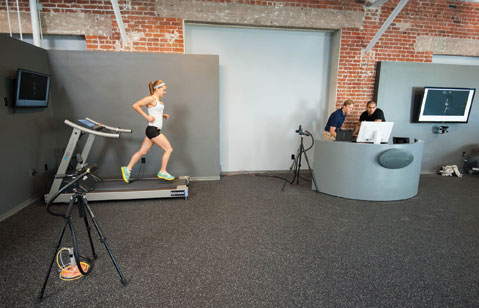ArthroKinetic Institute
Maury Hayashida and Tom Walters Help Us Move Correctly

Dr. Maury Hayashida wants us to train smarter, not harder. Hayashida, whose passion and expertise is the science of movement, firmly believes that the way we move is more important than the amount of exercise we do. Along with partner Tom Walters, he has launched the ArthroKinetic Institute (AKI) in Santa Barbara, a state-of-the-art facility designed to “identify, prevent, and correct human musculoskeletal system disorders.” With cutting-edge science and technology, doctors Hayashida and Waters have created a world-class resource usually found only in research settings.
This “MRI of Movement” is the future of diagnostic data, a system of measurable biomechanical technologies that yield data that cannot be ascertained with the human eye. AKI clinicians utilize high-speed cameras, force-plate technology, a pressure sensor-instrumented treadmill, and wireless electromyography (EMG) to evaluate walking, running, jumping, and balance issues. Through visual feedback and recommendations, individuals learn how to move mindfully and to self-correct. The use of these technologies also provides important information for physicians, therapists, trainers, and coaches to better treat and train movement patterns.
“The bottom line is that moving well translates into living well,” said Hayashida, a soft-spoken man whose clients range from a 15-year-old soccer player to an 85-year-old runner. “If you can’t do the things you want to do, there are social, mental, and emotional ramifications … On every level, movement affects your quality of life.” With athletes, the issue takes on an even greater intensity. Among his many credentials, Hayashida is the U.S.A. National Men’s and Women’s Rugby Rehabilitation Coordinator and physical therapist and tours with the men’s team internationally.
Ever since humans started walking upright, there have been skeletal issues, and experts now estimate that as many as 80 percent of the population will experience a back problem at some point in their lives. Walters and Hayashida want to change the present paradigm of movement, shifting it from a primarily therapeutic slant to a preventative one. They postulate that there are basic exercises that everyone should do every day, like “brushing your teeth” and that ideally, all physical-education teachers should incorporate these principles into their curriculum. Hayashida’s personal passion is the adolescent, between the ages of 9-14, whose “locomotor system is developing and can take one of two roads.” His goal is to impart the importance of protecting and investing in movement early so that by the time we reach our senior years, we can maintain our physical quality of life.
Contrary to popular belief, most injuries happen over a period of time and are caused by harmful repetitive movements that have never been corrected. Admittedly, movement reeducation is not easy, but according to Hayashida, everything can be undone to a certain amount depending on the compliance of the individual. Harmful patterns that have been instilled in the nervous system’s operations can be reprogrammed with intense repetitions and training in the space of four to six weeks. “It’s all about retraining the brain, the control center, which is ultimately what will organize and incorporate that new movement.”
4·1·1
The ArthroKinetic Institute is on 319 Anacapa Street. For more information, call 270-3004 or visit aki-sb.com.



